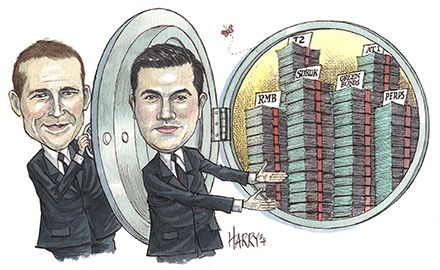Another record year for Asian bond issues saw one bank make jumbo deals and new structures look easy. For a track record of successful deals across the region and for leading the way in bank capital, HSBC is IFR Asia’s Bond House of the Year and Domestic Bond House of the Year.

Bond house, Domestic bond house
HSBC clocked up more records in the Asian bond markets in 2014, helping launch 171 G3 offerings for a total of over US$100bn during IFR’s review period as issuance from the region soared to new heights. However, HSBC had more than just muscle, with the bank putting on display its brainpower in bringing complex issues to market and, in leading the way in bank capital, the defining motif of the year.
Despite working on 25% more deals than any other arranger, HSBC managed to maintain its discipline, and avoided pulling offerings even in tough conditions, showing itself to be equally comfortable working for blue chips, debut issuers and high-yield borrowers.
“There were many important new developments in the Asian G3 market this year,” said Alexi Chan, head of debt capital markets, Asia Pacific, at HSBC. “These spanned regulatory capital, liability management, sustainable finance, high yield and beyond. Issuers consistently turned to HSBC for innovative capital-financing solutions.”
HSBC has established itself as the volume leader in Asian bonds in recent years, but it has also improved its high-yield capabilities and added to its structuring expertise. Investments in hybrid capital, particularly, paid dividends in 2014 as final Basel III regulations prompted a flurry of offerings of subordinated bank capital bonds, including October’s record issue from Bank of China.
HSBC was a global co-ordinator on the first US dollar Additional Tier 1 issue from Asia under Basel III, the US$300m non-call five perpetual bond from China Citic Bank International in April. It also helped Krung Thai Bank raise US$700m in the first US-dollar Basel III-compliant Tier 2 offering out of Thailand just weeks after a military coup.
BOC chose HSBC among nine bookrunners for its Rmb39.9bn (US$6.5bn) preference-share offering, the AT1 debut from China and the largest single-tranche issue in history in the Asian bond market. Weeks later, HSBC was a joint global co-ordinator on BOC’s US$3bn T2 issue, another first in the offshore market and a coveted repeat mandate from a bank that competes with HSBC in Hong Kong and China.
HSBC missed few jumbo deals during the period under review, and held key roles on more than most of its rivals. It managed both the US dollar and euro tranches of Hutchison Whampoa’s US$5.4bn three-tranche offering in October, helping the conglomerate secure its lowest coupon on record with the euro tranche and leaving negligible new-issue concessions.
The euro market was another area where HSBC led the way for Asian issuers. It was also bookrunner on the first dual-currency issue from an Indian borrower in May when Bharti Airtel printed a US$1bn and €750m paper and succeeded in pricing the euro tranche through its dollar curve. Then, in September, it handled the first euro-denominated Basel III T2 capital deal from an Asian lender, helping Bank of Communications bring its own dual-tranche deal to market, the first Chinese financial institution to issue in the currency.
Beyond vanilla
High-yield issuance was also a highlight in 2014. HSBC helped bring Tata Steel to market with Asia’s largest debut corporate high-yield bond, and enabled compatriot Samvardhana Motherson Automotive Systems to print a debut high-yield bond in euros from an Indian company.
It reopened the high-yield market for issuers in the China property sector, which investors have cold-shouldered many times during the year, in bringing Country Garden to market with a private placement and public offering over two days in May.
HSBC also added to its credentials in Islamic finance with Hong Kong’s first sukuk, helping set a precedent for issuers in Greater China. The US$1bn government deal printed at only 23bp over US Treasuries, the tightest spread achieved on a benchmark US dollar bond from an Asian government issuer outside Japan, and putting paid to the received wisdom that issuers of Islamic structures always needed to pay premiums.
The same month, HSBC was there when the Republic of Indonesia returned to the sukuk market with a US$1.5bn 10-year bond, drawing the largest book for any Asian sukuk at more than US$10bn. This was despite the new features of the wakala structure, becoming the first sovereign sukuk to incorporate elements of leasing and procurement within the structure.
HSBC was principal adviser when Export-Import Bank of Malaysia became the first such bank globally to issue in sukuk, and also acted as joint Sharia adviser, bookrunner and swap counterparty.
“There were many important new developments in the Asian G3 market this year. These spanned regulatory capital, liability management, sustainable finance, high yield and beyond. Issuers consistently turned to HSBC for innovative capital-financing solutions.”
Innovation was evident in its deals across Asia, with neat, accelerated switches on sovereign issues for the Philippines and Vietnam. On a sole bookrun issue for developer Sun Hung Kai Properties, HSBC came up with a 10-year bond that had a call option in year five and every subsequent coupon date, as well as a reset from fixed to floating for the final five years. This was the first such structure for an Asian offering, and helped SHKP maintain flexibility, while keeping its coupon payments at a record low.
HSBC was also active in helping issuers reach new types of investors. It was sole global co-ordinator for the first green offering from an Asian corporate issuer, managing chipmaker Advanced Semiconductor Engineering’s US$300m three-year bond, helping it to broaden its bondholder base. Then, in August, HSBC was joint lead manager when Maybank issued notes in the Tokyo Pro-Bond market, the first Malaysian issuer to do so.
Exotic structures like hybrid securities were no problem for HSBC. It brought energy company PTT Exploration and Production to market with a US$1bn subordinated perpetual bond just three weeks after Thailand’s military coup. A quick, clean execution helped PTTEP print the largest perpetual hybrid on record from South-East Asia.
Also this year, HSBC led the largest offshore perp from a state-owned corporate issuer, China Railway Construction Corp, and achieved the lowest coupon for a ratings agency-targeted hybrid from an Asian issuer, namely CLP Power.
It set the pace in issuance from the Asian insurance sector, including the first reinsurance hybrid offering: Korean Reinsurance’s US$200m 30-year non-call five subordinated extendible capital securities.
In the Asian local currency market, the year was full of groundbreaking deals. HSBC helped International Finance Corp bring the first Maharaja offering – an Indian rupee-denominated onshore bond from a foreign issuer – having been sole bookrunner in June, when IFC printed the first Green Dim Sum.
Local leader
Just as it had done with the Philippines’ US dollar debt, HSBC managed a domestic liability-management exercise for the sovereign, lengthening the average life of the accepted bonds for more than five years and decreasing the average coupon by 1.571%.
It brought the first Formosa bond from a supranational in October, when Cabei tapped the market. Then, a month later, it helped CCB Asia break the record for the largest Formosa bond in renminbi.
HSBC has established itself as the clear leader in the offshore renminbi market, and 2014 was no exception. As well as headline-grabbing issues like the UK Government’s debut offshore renminbi bond, it also broke new ground with “Lion City” renminbi bonds from Swiber Holdings, the first Singaporean corporate issuer to print a Singapore-cleared CNH deal, and helped Malaysia’s Cagamas make its renminbi debut with a Tiger Emas bond, cleared in Malaysia.
Throughout the year, it brought issuers like Unilever, Fonterra, Intesa Sanpaolo and Gazprombank to the renminbi market, and managed a Kimchi offering from Korea’s Woori Bank and a Formosa/Dim Sum from Kexim.
HSBC maintained its lead in almost every local currency bond market in Asia, again acting as the bank of choice for financial issuers looking to raise Basel III-compliant capital, and brought foreign issuers like ICICI Bank and UOB to the Australian dollar market, rounding off an impressive year across Asia.
To see the digital version of this report, please click here.
